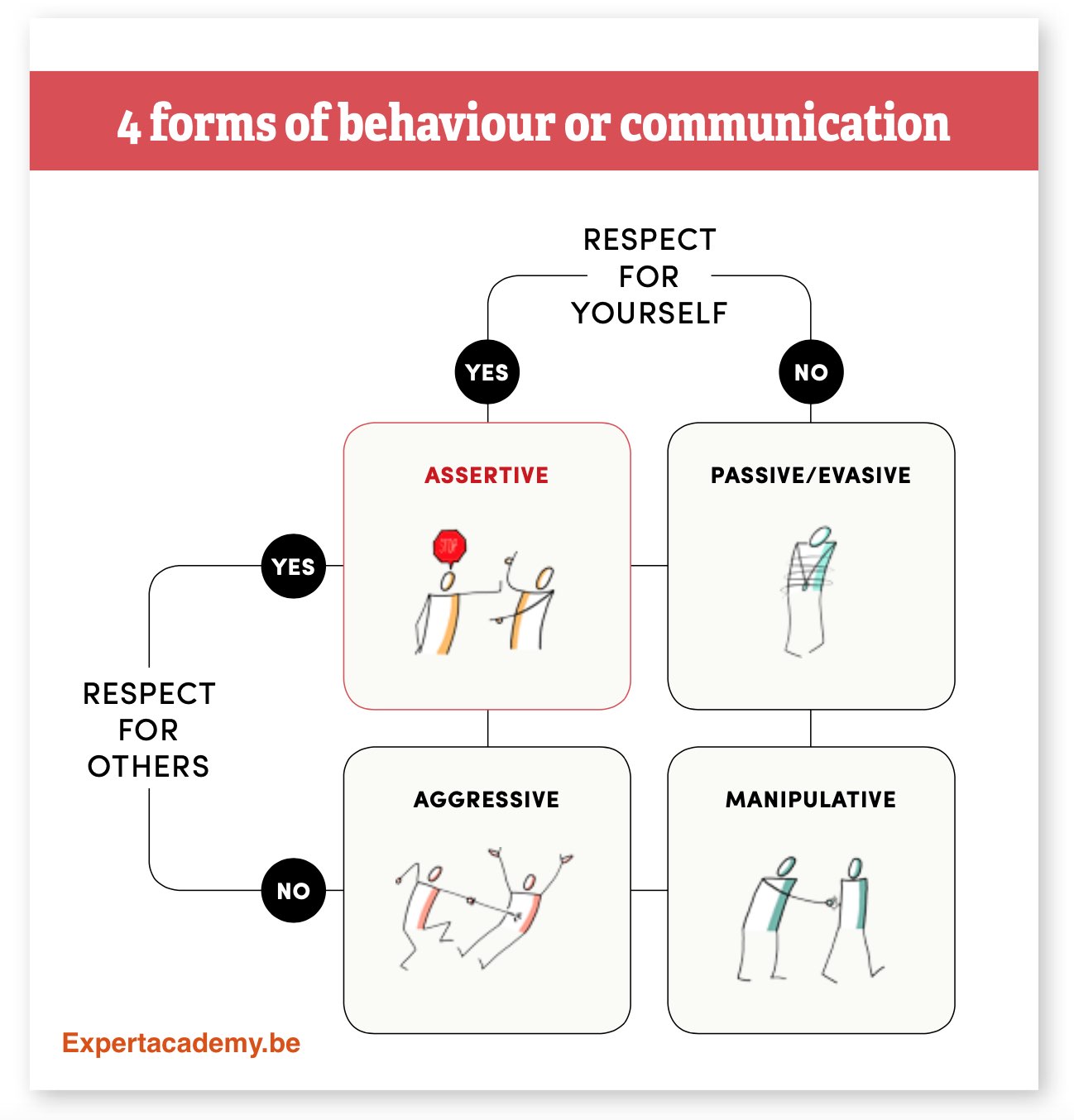What is Assertive Behaviour?
| Self confidence, Assertive behaviour, being assertive, Communication, assertiveness, Communication Assertive

When you ask a someone: "What is assertiveness?" you usually get "being confident" as an answer. But it is more than that. Being assertive actually means standing up for yourself while respecting others. This seems simple, yet in daily practice we often fail to be assertive. Why is that?
Actually there are 4 types of behaviour or communication. Assertiveness is one of them. Let's visualize people's behaviour/communication for a moment. We start from two conditions: respect for yourself and respect for the others.
In this way you arrive at four quadrants as shown in the diagram below.

It is essential to bear in mind that none of these forms of behaviour or communication are negative. Everything depends on the context or the situation. Let us put assertive behaviour on hold for a second, and concentrate on the other three zones first.
PASSIVE BEHAVIOUR
Let’s take a closer look at the zone where you have no respect for your own needs or interests but you focus entirely on the other person. You will soon end up in so- called passive/evasive behaviour, also referred to as sub-assertive. This is where you say “yes” all the time, often to avoid conflict. You tend to push back assignments, come up with excuses, apologise for everything, basically efface yourself. More often than not, other people will make decisions for you.
Often, people acting this way are eager to please, which takes them out of the spotlight and into the shadow.
An example:
A co-worker has been shifting work to you every Friday for the past few weeks with the reason "that he has an important appointment that Friday night, so he really can't finish that task.
Again this Friday you see that colleague coming and you immediately make the reflection: 'Oh no, here he comes again! I really don't like this! But I can't let him down, can I? What would happen if
I need him in the future? Or maybe he'll get upset with me, I don't like conflict. Besides, I have no idea how to tell them that I really don’t feel like taking over this job.'
Does this sound familiar to you? It is a perfect example of sub-assertive or evasive behaviour, where you decide to do exactly what you’d rather not. You take into account the other person’s needs, but neglect your own principles and priorities.
Your physical behaviour and body language will have an important effect as well. You probably will start to hesitate and avoid eye contact. You may try and hint at the inconvenience it causes you, but still you cave in at the slightest objection from your colleague and eventually you accept the job just the same.
AGGRESSIVE BEHAVIOUR
However, if you react to this situation in a way which is perceived by others as showing too much respect for yourself and none for the other person, we end up in the aggressive behaviour zone. You take on a selfish and dominant position, wanting or needing to come out as a winner no matter what, and systematically criticise the other person. Often this sort of behaviour is rooted in a feeling of superiority. You are Mr or Mrs Know-it-all. You are bulldozing the other person, as you indulge in anger, self-pity and intolerance.
Let’s go back to our previous example. As your colleague steps up to you, you think to yourself: “This can’t be true! He knows no shame! I’ve had it up to here!” In other words, this reflects how you think and feel, but has no consideration for what is important to the other person.
On a physical level, you might start losing your temper, getting worked up, raising your voice, shooting fire from your eyes, accusing and blaming the other person. This sort of behaviour does not always have to be blatantly visible, it can be far more subtle, where you become overly sarcastic and cynical.
Result: you are not taking over the job. But the conversation on the topic was not constructive. Your relationship with this colleague has become increasingly bitter and there is not much hope for improvement.
MANIPULATIVE BEHAVIOUR
If you deal with this situation without showing respect both for yourself or the other person, you will automatically end up in the manipulative behaviour zone. A manipulator’s goal is to gain an advantage in the short term, often by accusing other people. They are likely to
exploit a situation, acting behind the back, or gossiping to achieve theif goals. As a result, they often come across as unreliable to most people.
Translated into our little situation, it goes like this: “Oh dear, here he comes again. How am I going to weasel my way out of that one? I don’t feel like getting into a row or having to justify myself. You know what! I will just tell him that I have a doctor’s appointment, and that it cannot be rescheduled.”
In other words, telling a lie. In the short term, you will meet your own needs. However you are not achieving your main objective: letting the other person know that you are not happy with the situation, that you’re feeling used and you would like to find a long term solution.
Another approach: You tell your colleague “Well okay then, I’ll do it”, as your body language and tone of voice express exactly the opposite. As soon as your colleague has left, you turn to the colleague you share your office with: “Can you believe that? Every Friday afternoon! All he thinks of is himself. This is not just about handing his jobs over to me, oh no, it’s also about...”
This is what manipulative people do constantly, at the coffee corner, during lunch breaks, in meetings, in fact every chance they get. They’re trying to influence their environment, without helping to solve a particular situation. In most cases, they’re achieving quite the opposite result, as the atmosphere on the work floor is heavily affected, undermining trust and confidence among co-workers in the long run.
ASSERTIVE BEHAVIOUR
Only by respecting yourself and the other person in the same situation, will you show genuine assertive behaviour. You dare to say “no” when you decide to, and “yes” if you feel that that is the right choice. You have no difficulty in admitting that you don’t understand or don’t agree to a particular situation.
Translated to our example, it goes something like this. You see your colleague walking up to you, and you’re thinking: Oh no, not again! I don’t like this. I feel used and that is not something I want to feel right now. I must tackle this issue with him now, and tell him once and for all that I do not wish to continue like this”
In other words, you’re sharing with the other person what is important to you, thus respectfully meeting your own needs. And, you are also being considerate of the other person’s expectations by approaching him with respect. This does not mean you have to execute what that person asks you to do on their behalf.
It could go like this: ‘For the past 5 weeks you have asked me to take over your job, because you had to leave urgently. A number of times I’ve been happy to help out. However, I am starting to get the feeling that you are just taking advantage of me. I’m sure that it is completely unintentional, but this is how I perceive the situation. To me it is important that “helping out” is a two-way street. And this situation is completely out of balance for me.”
This is a far more assertive way of dealing with the matter, creating clarity for both parties.
More information: Assertive Communication







